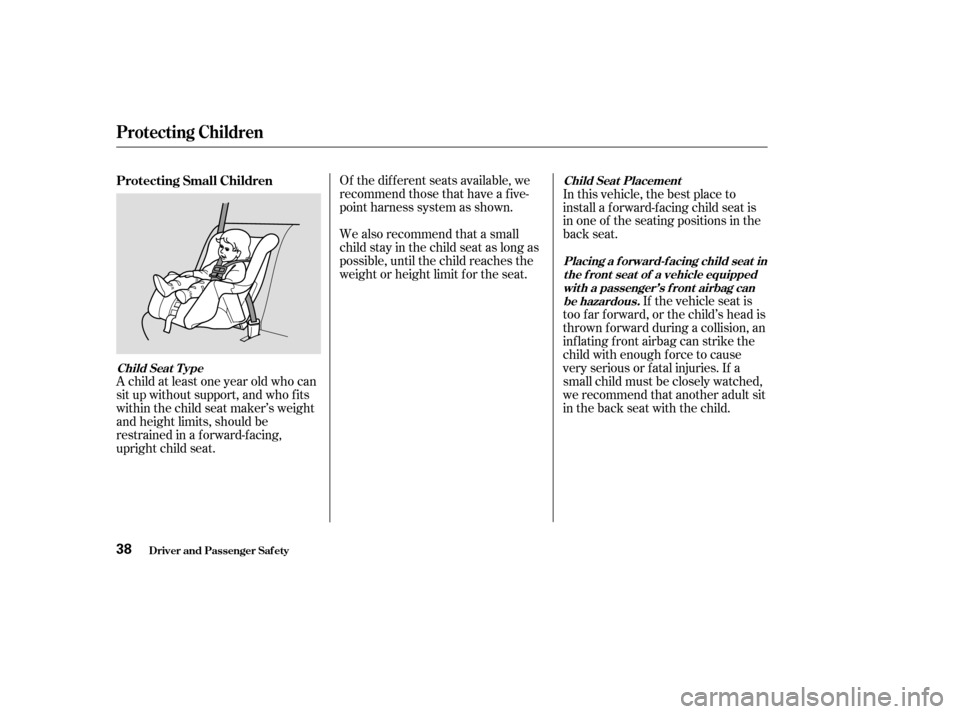2003 HONDA CR-V height
[x] Cancel search: heightPage 22 of 374

This could cause
very serious injuries in a crash.
If the seat belt touches or crosses
your neck, or if it crosses your arm
instead of your shoulder, you need to
adjust the seat belt anchor height.
To adjust the height of a f ront seat
belt anchor, squeeze the two release
buttons and slide the anchor up or
down as needed (it has f our
positions).
Driver and Passenger Saf ety
Protecting Adults
Never place t he shoulder port ion of alap/shoulder belt under your arm orbehind your back.
18
RELEASE BUTTONS
Page 38 of 374

Only a rear-f acing child seat provides
proper support f or a baby’s head,
neck, and back. Inf ants up to about
one year of age must be restrained in
a rear-f acing child seat.
Two types of seats may be used: a
seat designed exclusively f or inf ants,
or a convertible seat used in the rear-
f acing, reclining mode.In this vehicle, a rear-f acing child
seatcanbeplacedinanyseating
position in the back, but not in the
front seat.
If the passenger’s
f ront airbag inf lates, it can hit the
back of the child seat with enough
f orce to kill or seriously injure an
inf ant. If an inf ant must be closely
watched, we recommend that
another adult sit in the back seat
with the baby.
If placed
f acing f orward, an inf ant could be
very seriously injured during a
f rontal collision.
We recommend that an inf ant be
restrained in a rear-f acing child seat
until the inf ant is at least one year
old, reaches the seat maker’s weight
or height limit, and is able to sit up
without support.
Protecting Inf ants
Child Seat T ype
Rear-Facing Child Seat Placement
Never put a rear-f acing child seat inthe front seat.
Do not put a rear-f acing child seat ina f orward-f acing position.
Protecting Children
Driver and Passenger Saf ety34
Placing a rear-facing child seat
in the front seat can result in
serious injury or death if the
passenger’s front airbag inflates.
Always place a rear-facing child
seat in the back seat, not the
front.
Page 42 of 374

Of the different seats available, we
recommend those that have a f ive-
point harness system as shown.
We also recommend that a small
child stay in the child seat as long as
possible, until the child reaches the
weight or height limit f or the seat.In this vehicle, the best place to
install a f orward-f acing child seat is
in one of the seating positions in the
back seat.
If the vehicle seat is
too far forward, or the child’s head is
thrown f orward during a collision, an
inflating front airbag can strike the
child with enough f orce to cause
very serious or f atal injuries. If a
small child must be closely watched,
we recommend that another adult sit
in the back seat with the child.
A child at least one year old who can
sit up without support, and who f its
within the child seat maker’s weight
and height limits, should be
restrained in a f orward-f acing,
upright child seat. Protecting Small Children
Child Seat T ype Child Seat Placement
Placing a f orward-f acing child seat int he f ront seat of a vehicle equippedwit h a passenger’s f ront airbag canbe hazardous.
Protecting Children
Driver and Passenger Saf ety38
Page 46 of 374

When a child reaches the
recommended weight or height limit
for a forward-facing child seat, the
child should sit in the back seat on a
booster and wear a lap/shoulder belt.
We recommend that the child use a
booster seat until the child is tall
enough to use the seat belt without a
booster.
The f ollowing pages give
instructions on how to check proper
seat belt f it, what kind of booster
seat to use if one is needed, and
important precautions f or a child
who must sit in the f ront seat.To determine if a lap/shoulder belt
properly f its a child, have the child
sit in the rear seat, all the way back
against the seat and have them put
on the seat belt. Follow the
instructions on page . Then check
how the belt f its.
17
Protecting L arger Children
Checking Seat Belt Fit
Protecting Children
Driver and Passenger Saf ety42
Allowing a larger child to sit
improperly in the front seat can
result in injury or death if the
passenger’s front airbag inflates.
If a larger child must sit in front,
make sure the child moves the
seat as far back as possible,
uses a booster seat if needed,
and wears the seat belt properly.
Page 67 of 374

This section gives inf ormation about
the controls and displays that
contribute to the daily operation of
your Honda. All the essential
controls are within easy reach............................
Control Locations .64
...............................
Indicator Lights .65
.............................................
Gauges .72
...............................
Speedometer .72
.................................
Tachometer .72
..............
Odometer/Trip Meter . 73
Outside Temperature ..................................
Indicator .73
..................................
Fuel Gauge .74
...................
Temperature Gauge . 74
Controls Near the Steering .......................................
Wheel .75
...................................
Headlights .76 ............
Daytime Running Lights . 77
....
Instrument Panel Brightness . 77
................................
Turn Signals .77
.....................
Windshield Wipers .78
..................
Windshield Washers . 79
Rear Window Wiper and .....................................
Washer .80
..........................
Hazard Warning .81
.............
Rear Window Def ogger . 81
.............................
Parking Brake .82
......
Steering Wheel Adjustment . 83
...............................
Keys and Locks .84
..............................................
Keys .84
....................
Immobilizer System . 85
............................
Ignition Switch .86
......................
Power Door Locks .88
...................
Remote Transmitter . 89
..............
Childproof Door Locks . 93
........................................
Tailgate .93
....................................
Glove Box .96
.................................................
Seats .97
.............
Front Seat Adjustments . 97
Driver’s Seat Height ..............................
Adjustment .98
...................
FrontSeatArmrests . 98
..........................
Head Restraints .99 ............
Rear Seat Adjustments . 100
....................
Rear Seat Armrest .101
........
Reclining the Front Seats . 102
.............
Folding the Rear Seats . 104
...................
Detachable Anchor . 108
..................................
Seat Heaters .109
............................
Power Windows .110
.......................................
Moonroof .113
...........................................
Mirrors .114
..
Adjusting the Power Mirrors . 114
..................................
Center Table .115
.........................
Beverage Holders .116
.................................
Built-in Table .117
...............................
Center Pocket .119
...................................
Storage Box .119
.............................
Driver’s Pocket .120
.......................................
Coin Tray .120
........................
Sunglasses Holder .121
............
Accessory Power Sockets . 122
........................
Dashboard Pocket .123
...............................
Interior Lights .124
..............................
Ceiling Light .124
...................................
Spotlights .124
......................
Cargo Area Light .125
................
Ignition Switch Light . 125
Instruments and Controls
Inst rument s and Cont rols63
Page 102 of 374

To adjust the height of the driver’s
seat, turn the dial on the outside of
theseatbottom.Eachfrontseathasanarmreston
thesideof theseat-back.Touseit,
pivotitdown.Only on vehicles with an automatic
transmission
Driver’s Seat Height Adjustment Front Seat Armrests
Inst rument s and Cont rols
Seats
98
Page 103 of 374

See page f or important saf etyinf ormation and a warning about how toproperly position the head restraints. 16
Your vehicle is equipped with head
restraints in all seating positions.
The head restraints help protect you
and your passengers f rom whiplash
and other injuries. They are most
ef f ective when you adjust them so
the back of the occupant’s head rests
against the center of the restraint. A
taller person should adjust the
restraint as high as possible.
The head restraints in the f ront and
rear outboard seating positions
adjust f or height. You need both
hands to adjust the restraint. Do not
attempt to adjust it while driving. To
raise it, pull upward. To lower the
restraint, push the release button
sideways and push the restraint
down.To remove a f ront head restraint or a
head restraint in one of the rear
outboard seating positions f or
cleaning or repair, pull it up as f ar as
it will go. Push the release button,
then pull the restraint out of the seat-
back.
To remove the rear center head
restraint, pull it up and out of the
seat-back.
Head Restraints
Seats
Inst rument s and Cont rols99
REAR CENTER
RELEASE BUTTON
Page 226 of 374

The added weight, length, and
height of a trailer will af f ect your
vehicle’s handling and perf ormance,
so driving with a trailer requires
some special driving skills and
techniques.
Foryoursafetyandthesafetyof
others,taketimetopracticedriving
maneuvers bef ore heading f or the
open road, and f ollow the guidelines
discussed below.If the automatic transmission shif ts
f requently between 3rd and 4th
gears while going up a hill, turn of f
the Over drive (O/D) mode (see
page ). When climbing hills, closely watch
your temperature gauge. If it nears
the red mark, turn the air
conditioning of f , reduce speed and, if
necessary, pull to the side of the
road to let the engine cool.
Make turns more slowly and wider
than normal. The trailer tracks a
smaller arc than your vehicle, and it
canhitorrunoversomethingthe
vehicle misses. Allow more time and
distance f or braking. Do not brake or
turn suddenly as this could cause the
trailer to jackknif e or turn over. Drive slower than normal in all
driving situations, and obey posted
speed limits f or vehicles with trailers.
If you have an automatic
transmission, use the Over drive
(O/D) mode when towing a trailer
on level roads. Turn of f the Over
drive (O/D) mode when towing a
trailer in hilly terrain (see page ).
(See ‘‘ ’’ in the next
column f or additional gear
inf ormation.)
If youmuststopwhenfacinguphill,
use the f oot brake or parking brake.
Do not try to hold the vehicle in
placebypressingontheaccelerator,
as this can cause the automatic
transmission to overheat.
207
207
Driving Saf ely With a T railer
Towing a Trailer
Driving
Driving on Hills
Making T urns and Braking Driving on Hills
T owing Speeds and Gears
222